

POSTS |CTF WRITEUP
Another part of my series of CTF write-ups from ADFCSC 2023, this time a ransomware challenge in the ‘Investigation’ category.
| Difficulty Rating | Satisfaction Rating |
|---|---|
| Moderate Low | Very high! |
Set up
Help! Your friend has had their (100MB) USB drive encrypted with some sort of ransomware attack! The attacker is asking for 💯 bitcoins to decrypt it!! Can you help? Your friend managed to get the encryption binary too.
We have been provided with two zip files:
- encryptorjLBXpK3gz.zip (4 KB)
- volumeC11m7Xo1Zb.zip (100 MB)
These two files inflate to the following:
- encryptor
$ file encryptor encryptor: ELF 64-bit LSB shared object, x86-64, version 1 (SYSV), dynamically linked, interpreter /lib64/ld-linux-x86-64.so.2, BuildID[sha1]=9ca7c655b313fe2d63bff9dc2805ad7f3b4d25ae, for GNU/Linux 3.2.0, stripped - volume.bin
$ file volume.bin volume.bin: data
We can safely assume that the volume.bin is a container file for the entire file-system that has been encrypted. Therefor if this was not encrypted and instead recognised by file as some form of boot sector or file-system, we would be able to mount it to a folder using the mount command and a loop device. Something like:
$ mkdir test_dir
$ sudo mount -o loop volume.bin test_dir/
For now, we are going to put this file aside and focus on the encryptor tool. As it is generally ill-advised to run tools that may encrypt your drives, let’s do a bit of reverse engineering and binary analysis first to determine its danger rating. As the old proverb goes, ‘everything is a nailbinary analysis when you have a hammerstrings’.
$ strings encryptor
... snip ...
********************************************************************************
*
*
* THE TARGETED USB STICK DATA LOCKER *
* This piece of software is a targeted USB stick data encryptor. It has been *
* designed to only encrypt a single targeted FAT volume. It will not lock any *
* FAT volume. Once locked you can then request a ransom. *
Enter the path of the FAT volume to encrypt:
... snip ...
This alone is enough to tell us that it isn’t going to auto-detect any drives on the system and go around encrypting them. Especially since it says it only targets FAT volumes, of which I have none. Of course, I am still running in a disposable Kali VM, but I trust it enough to spin it up and see what we get.
┌──(Lilith㉿kali)-[~/adfctf/Ransom]
└─$ ./encryptor
********************************************************************************
* *
* THE TARGETED USB STICK DATA LOCKER *
* *
* This piece of software is a targeted USB stick data encryptor. It has been *
* designed to only encrypt a single targeted FAT volume. It will not lock any *
* FAT volume. Once locked you can then request a ransom. *
* *
********************************************************************************
Enter the path of the FAT volume to encrypt: volume.bin
[+] Successfully opened specified file for reading.
[+] The size of file to be encrypted is 104857600 bytes.
[+] Volume serial number successfully read.
[!] Requested file is not the expected volume target. Aborting.
Notice how I specified the volume.bin file as the target volume to encrypt? It seems that the encryptor is expecting files over mounted volumes, so we don’t need to run around mounting the device first then specifying the particular /dev/loopN device it may be mounted against. This is good, it makes our life just a tiny bit easier. Also note how it does some form of validation against the volume and errors out - since it’s reading the volume serial number, we can assume that its using something like the magic byte sequence in the file-system superblock to validate the target. Let’s crack open the binary and see what we can work out.
You might have noticed when we ran file on the extractor earlier that it is a stripped binary, this only serves to slightly lengthen our reverse engineering process but ultimately will not hinder us much. We will use Ghidra to perform the disassembly and decompilation of the binary. First up, load up a new project and import the binary, then open it in the code viewer and analyse it when prompted, this lands us here:
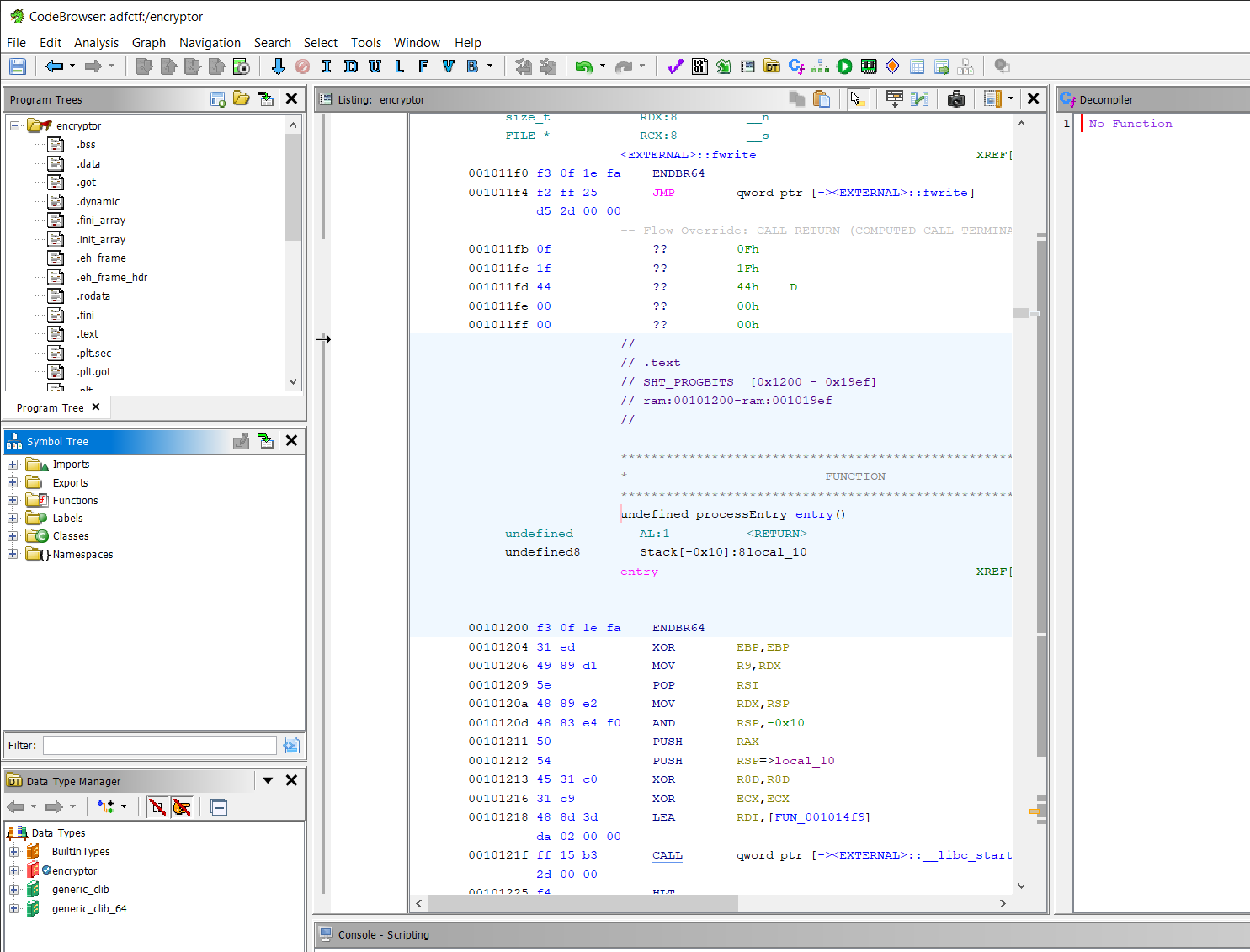
Since this is a stripped binary (and likely optimised), the assembly isn’t going to be that human readable, so lets identify the ‘main’ function of the program. All ELF (Executable Linking Format) binaries have an ‘entrypoint’ function, which is where the program begins before calling the main function. Ghidra is always able to identify this ‘entrypoint’ function regardless of if the binary is stripped due to the fact its address in codespace is hardcoded into the ELF file header. We can use this entry function to identify the main function, as in a standard C program, the main function will be passed as an argument function pointer to the __libc_start_main function.
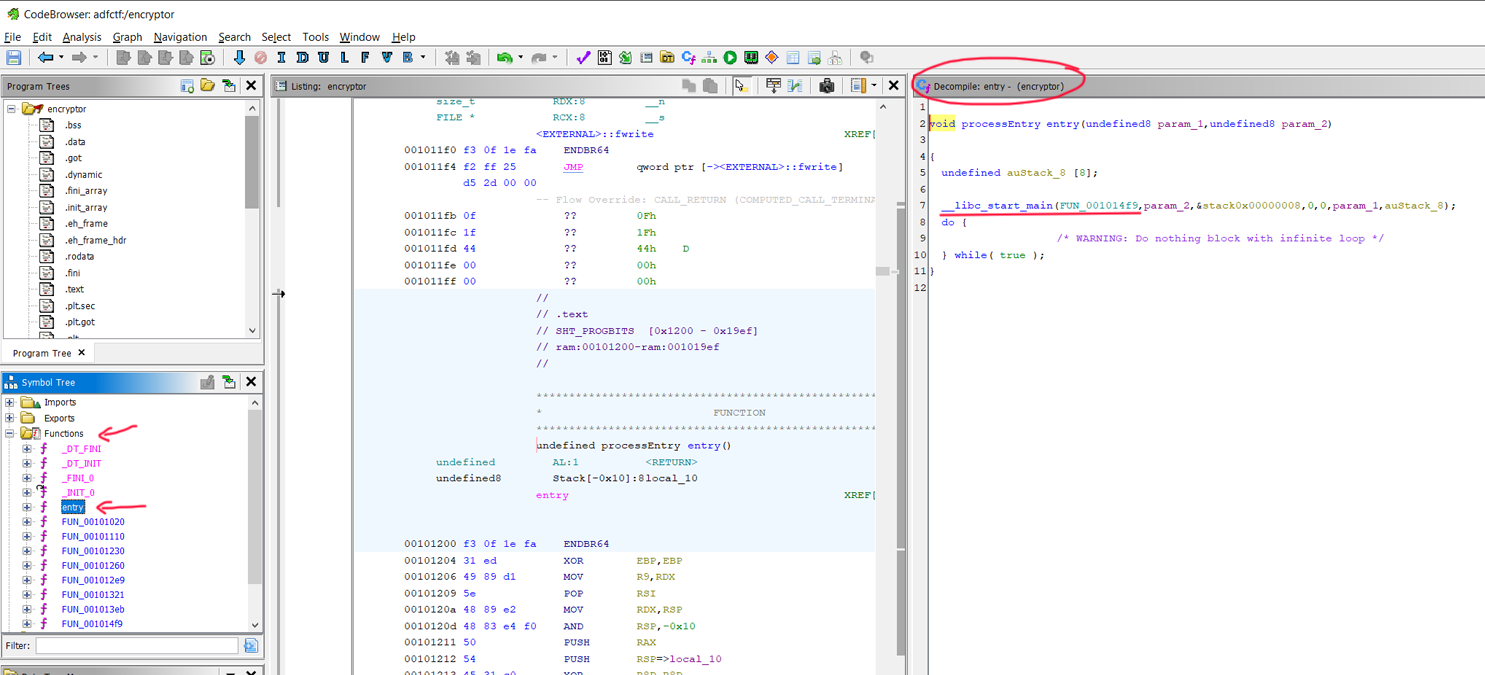
Here we can see a function that Ghidra has identified as FUN_001014f9 is passed as an argument to __libc_start_main, so we can assume this is the main function. Ghidra will let us rename this function, so while we’re here, lets rename it to main.
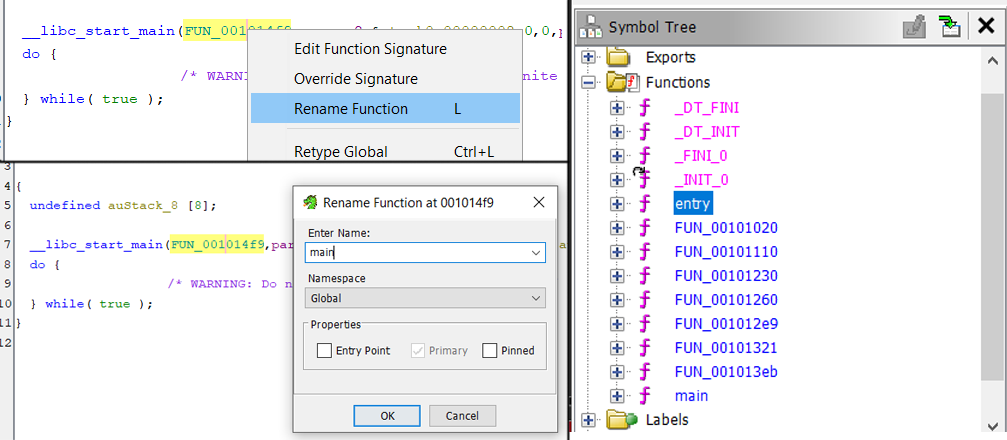
Now we are able to decompile the main function, which turns out to be about 120 lines of stripped C code, with the important bits being the following:
printf("Enter the path of the FAT volume to encrypt: ");
__isoc99_scanf(&DAT_00102246,local_188);
putchar(10);
local_240 = fopen(local_188,"rb");
if (local_240 == (FILE *)0x0) {
puts("[!] Unable to open specified file for reading. Aborting.");
uVar2 = 0xffffffff;
}
else {
puts("[+] Successfully opened specified file for reading.");
iVar1 = stat(local_188,&local_228);
if (iVar1 == 0) {
printf("[+] The size of file to be encrypted is %ld bytes.\n",local_228.st_size);
local_244 = 0x347726c9;
fseek(local_240,0x27,0);
sVar3 = fread(&local_248,4,1,local_240);
if (sVar3 == 1) {
puts("[+] Volume serial number successfully read.");
if (local_244 == local_248) {
puts("[+] Requested file is the expected volume target.");
rewind(local_240);
local_238 = malloc(local_228.st_size);
sVar3 = fread(local_238,1,local_228.st_size,local_240);
if (sVar3 == local_228.st_size) {
puts("[+] Volume successfully read.");
fclose(local_240);
local_198 = 0x74b44da6d2c0fe2c;
local_190 = 0x71528916c1391e5;
FUN_00101321(local_118,0x10,&local_198);
local_230 = malloc(local_228.st_size);
FUN_001013eb(local_118,local_228.st_size,local_238,local_230);
puts("[+] Volume data successfully encrypted in memory.");
free(local_238);
local_240 = fopen(local_188,"wb");
if (local_240 == (FILE *)0x0) {
puts("[!] Unable to open specified file for writing. Aborting.");
free(local_230);
uVar2 = 0xffffffff;
}
else {
puts("[+] Successfully opened specified file for writing.");
sVar3 = fwrite(local_230,1,local_228.st_size,local_240);
if (sVar3 == local_228.st_size) {
puts("[+] Encrypted volume successfully written.");
free(local_230);
fclose(local_240);
puts("[+] Done.");
uVar2 = 0;
}
Now, as you probably very quickly decided, this is a nightmare to read and understand. Variables aren’t named, the code isn’t succint, there’s no comments… And unfortunately the only way to really get around this is to spend the time analysing what the code is doing and renaming variables and functions until it’s more readable. I will save you the effort and do it ‘off camera’. Here are some important bits I extracted from the above method (bonus points if you can work out which sections correspond to which):
if (read_status == stat_buffer.st_size) {
puts("[+] Volume successfully read.");
fclose(f_status);
key_password_1 = 0x74b44da6d2c0fe2c;
key_password_2 = 0x71528916c1391e5;
key_generator(key, 0x10, &key_password_1); // <----- function of interest 1
encrypted_volume_buff = malloc(stat_buffer.st_size);
volume_encrypt( // <----- function of interest 2
key,
stat_buffer.st_size,
plaintext_volume_buff,
encrypted_volume_buff
);
puts("[+] Volume data successfully encrypted in memory.");
free(plaintext_volume_buff);
// ...
}
Now this begins to make a bit more sense. If you notice the first ‘function of interest’, we have some sort of password based key derivation function (PBKDF), with a hardcoded password. Then we have some form of encryption algorithm that takes this key.
void volume_encrypt(long key,ulong size,long plaintext,long ciphertext) {
int byte_ctr = 0;
int keyed_byte_ctr = 0;
for (int i = 0; (ulong)(long)i < size; i = i + 1) {
byte_ctr = (byte_ctr + 1) % 256;
keyed_byte_ctr = (int)(keyed_byte_ctr + (uint)*(byte *)(key + byte_ctr)) % 256;
deref_and_swap(key + byte_ctr,keyed_byte_ctr + key);
*(byte *)(ciphertext + i) =
*(byte *)(plaintext + i) ^ // <--- operation of interest
*(byte *)(key + (ulong)(byte)(*(char *)(key + keyed_byte_ctr) + *(char *)(key + byte_ctr) ))
;
}
return;
}
Ignoring the awful type-casting introduced by the compilation-decompilation process, we can begin to see some form of ‘encryption’ algorithm forming. Primarily, we are XOR’ing each byte of the plaintext with some transformation of the current byte of the keystream. How exactly we modify this is now irrelevant at this point, since due to the associativity of XOR, the encrypt operation is the same as the decrypt operation. Given we can construct the same key, running the encrypted volume through this function will decrypt it, by associativity.
void key_generator(long key_buff,int key_len,long password) {
int key_byte = 0;
for (int i = 0; i < 256; i = i + 1) {
*(char *)(key_buff + i) = (char)i;
}
for (int k = 0; k < 256; k = k + 1) {
key_byte = (int)((uint)*(byte *)(password + k % key_len) +
(uint)*(byte *)(key_buff + k) + key_byte) % 256;
deref_and_swap(key_buff + k, key_byte + key_buff);
}
return;
}
We can see that, however we are actually constructing the key, there are no random elements involved. Thus the same key will be generated from this PBKDF function every time the encryptor is run. Since we are generating the same key, and the encryption function is associative, if we can just run the program on the encrypted volume again, it should decrypt. You might have noticed that upon the first trial run, we errored out when trying this with:
Enter the path of the FAT volume to encrypt: volume.bin
[+] Successfully opened specified file for reading.
[+] The size of file to be encrypted is 104857600 bytes.
[+] Volume serial number successfully read.
[!] Requested file is not the expected volume target. Aborting.
We can see that this error occurs here:
read_status = fread(&volume_identifier,4,1,f_status);
if (read_status == 1) {
puts("[+] Volume serial number successfully read.");
if (magic_bytes == volume_identifier) {
// ... do rest of process
} else {
puts("[!] Requested file is not the expected volume target. Aborting.");
fclose(f_status);
exit_code = -1;
}
}
Seeing as that volume_identifier variable isn’t used again after that point and isn’t relevant to the function of the program, we can perform a binary modification to invert the condition of the if statement to continue the desired control flow. We can safely assume that this check is failing because the encrypted volume obviously no longer has the same magic bytes.

We can see the if condition is encoded as a cmp op-code followed by a jz opcode. But note that if we invert the condition of the if statement, that is the same as inverting the jump targets for the true and false branches. And that is the same as flipping the jump condition (indicated by the character(s) after the ‘j’ of the opcode. jz indicates ‘jump if zero’).
| Instruction | Description | Flags | short jump opcodes | near jump opcodes |
|---|---|---|---|---|
| JE | Jump if equal | ZF=1 | 74 | 0F 84 |
| JZ | Jump if zero | ZF=1 | 74 | 0F 84 |
| JNE | Jump if not equal | ZF=0 | 75 | 0F 85 |
| JNZ | Jump if not zero | ZF=0 | 75 | 0F 85 |
This Intel x86 Quick reference table from Steve Friedl shows that if we want to invert the jump condition, its as simple as changing the 74 28 of the jump opcode to a 75 28. This is a single byte change that we can implement using the hexedit tool in the terminal.
A quick trick for finding the correct byte in the binary to edit is to search for a hex-string that includes an instruction or two after the targeted instruction, as that is less likely to appear more than once.

Here I am inclined to search for the hex string 74 28 48 8d 05 44 0c 00 00.
$ hexedit encryptor
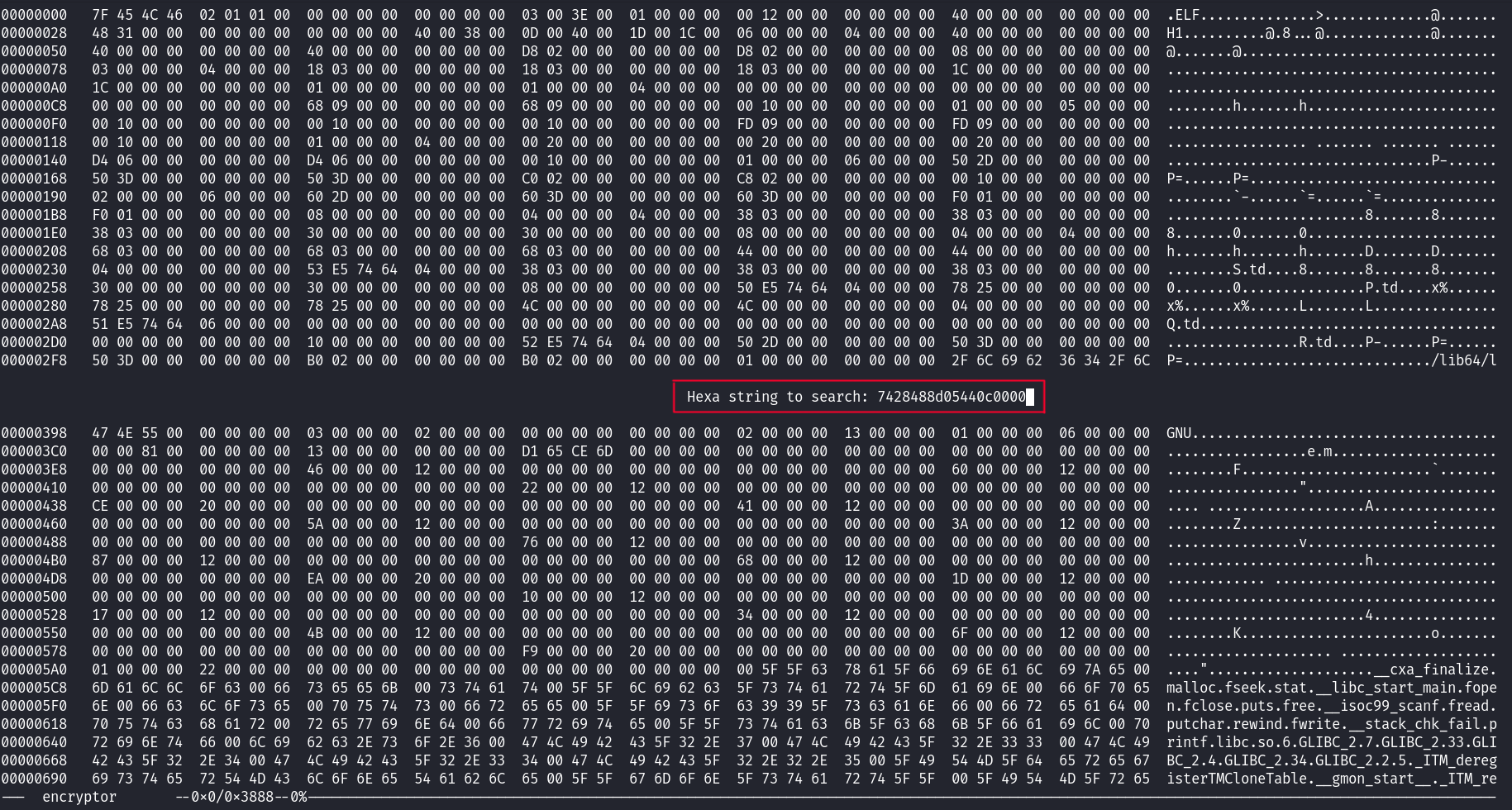
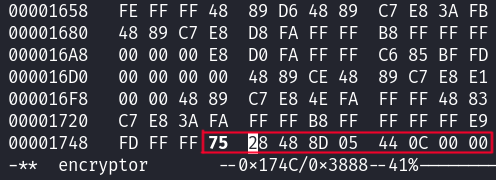
Notice the ‘bolded’ 75 indicating a change has been made.
Now that we’ve made that change, we can run the program against the encrypted volume.
┌──(lilith㉿kali)-[~/adfctf/Ransom]
└─$ ./encryptor
********************************************************************************
* *
* THE TARGETED USB STICK DATA LOCKER *
* *
* This piece of software is a targeted USB stick data encryptor. It has been *
* designed to only encrypt a single targeted FAT volume. It will not lock any *
* FAT volume. Once locked you can then request a ransom. *
* *
********************************************************************************
Enter the path of the FAT volume to encrypt: volume.bin
[+] Successfully opened specified file for reading.
[+] The size of file to be encrypted is 104857600 bytes.
[+] Volume serial number successfully read.
[+] Requested file is the expected volume target.
[+] Volume successfully read.
[+] Volume data successfully encrypted in memory.
[+] Successfully opened specified file for writing.
[+] Encrypted volume successfully written.
[+] Done.
Great! We ran right through to completion and didn’t encounter anymore errors. Lets check the volume now:
┌──(lilith㉿kali)-[~/adfctf/Ransom]
└─$ file volume.bin
volume.bin: DOS/MBR boot sector, code offset 0x3c+2, OEM-ID "mkfs.fat", sectors/cluster 4, reserved sectors 4, root entries 512, Media descriptor 0xf8, sectors/FAT 200, sectors/track 32, heads 8, sectors 204800 (volumes > 32 MB), serial number 0x347726c9, unlabeled, FAT (16 bit)
Great! We now recognise the volume as a disk boot sector, and later in the file output it identifies as a FAT volume. Lets try and mount it against a loop device.
┌──(lilith㉿kali)-[~/adfctf/Ransom]
└─$ mkdir testdir
┌──(lilith㉿kali)-[~/adfctf/Ransom]
└─$ sudo mount -o loop volume.bin testdir
[sudo] password for lilith:
mount didn’t return any errors, so lets try and read it!
┌──(lilith㉿kali)-[~/adfctf/Ransom]
└─$ ls testdir
flag.txt
┌──(lilith㉿kali)-[~/adfctf/Ransom]
└─$ cat testdir/flag.txt
FLAG{YoUCanTExT0rTMe!}
Amazing!
So to recap, we:
- Identified the tool doesn’t behave maliciously on its own
- Reverse engineered the functions in the stripped
encryptorbinary - Identified a hard-coded password, and a PBKDF being used to generate the encryption keys
- Identified that the encryption function was associative
- Performed a binary modification on the
encryptorto allow us to run it on unrecognised volumes - Used the modified binary to decrypt the encrypted volume by associativity
- Extracted the flag from the newly decrypted volume.
